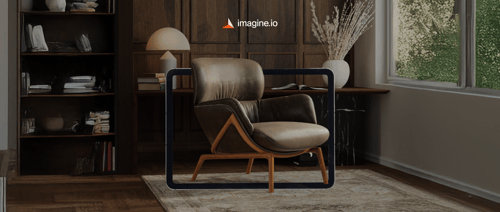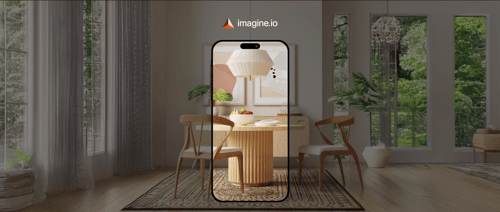Quick Listen:
Imagine browsing an online furniture store, captivated by a modern sectional sofa. Its clean lines and plush fabric are tempting, but doubt creeps in: will it overwhelm your small living room? Will the color clash with your decor? Once, you'd have to gamble, order it, and pray it worked. Now, a single tap on your smartphone can resolve the uncertainty. Using augmented reality (AR), that sofa materializes in your space, digitally anchored to your floor, viewable from every angle. This isn't a futuristic fantasy it's the present of furniture retail, and it's reshaping how we shop.
The furniture industry, historically reliant on physical showrooms, is embracing a digital transformation. Online shopping's rise has exposed a core challenge: how do you confidently purchase a bed you can't touch or a table you can't size up in person? AR, which overlays digital images onto the real world via smartphones or AR glasses, offers a solution. Far from a novelty, it's a booming market. According to a Market Research Future report, the AR shopping sector, valued at $3.6 billion in 2023, is forecast to soar to $50 billion by 2035, with a robust 24.5% compound annual growth rate. Furniture retail, plagued by high return rates and complex purchases, is leading this charge.
A Digital Showroom at Your Fingertips
AR's ascent in furniture shopping is driven by consumer demand for engaging, interactive experiences. Shoppers want more than static images they want to visualize products in their own homes. AR delivers, enabling you to “place” a coffee table in your lounge or a wardrobe in your bedroom, rendered with striking realism. Curious if a teal armchair complements your walls? AR reveals the answer instantly. This technology bridges the divide between online browsing and in-store assurance, reducing the uncertainty that drives returns.
Advancements in AR are fueling its adoption. Enhanced object recognition, smooth integration with e-commerce platforms, and lifelike 3D renderings elevate the experience from gimmick to essential tool. A Market.us analysis predicts the global AR shopping market will reach $54.7 billion by 2033, up from $4 billion in 2023, with a 29.9% growth rate. Smartphones, nearly universal, are the ideal medium. Launch an app, point your camera, and your home transforms into a virtual showroom. For retailers, the benefits are tangible: increased engagement, higher sales, and fewer returns.
Major retailers are capitalizing on this trend. IKEA's Place app allows precise placement of furniture in your space, while Wayfair's View in Room feature offers similar functionality. These tools drive measurable outcomes. Research indicates AR enhances conversion rates and customer satisfaction, empowering shoppers to buy with confidence. One furniture retailer saw returns drop significantly after implementing AR, a figure that resonates with industry leaders.
Virtual Try-Before-You-Buy
AR's appeal lies in its intuitive design. Open an app, aim your phone, and a dining set appears in your kitchen. You can circle it, ensure it fits, or tweak its finish to suit your style. This “try-before-you-buy” model is transformative. As noted by Fortune Business Insights, AR improves shopping for furniture, fashion, and cosmetics by making it more convenient and immersive. It's no surprise shoppers are embracing it.
AR also yields valuable data. Retailers can monitor which items customers “test” virtually, uncovering trends and preferences. If oak bookshelves are a hit in virtual trials, that's a cue to prioritize them. This data streamlines inventory and sharpens marketing, converting browsers into buyers. For consumers, the benefit is clarity no more deciphering vague measurements or hoping a “neutral beige” isn't garish in reality.
Navigating AR's Challenges
Despite its promise, AR faces obstacles. Creating high-quality 3D models is resource-intensive, a barrier for smaller retailers compared to giants like IKEA. The technology also demands significant processing power; rendering a detailed sofa in real time can strain smartphones, and glitches such as jittery visuals or misaligned objects can frustrate users.
Consumer adoption poses another hurdle. While tech-savvy younger shoppers dive in, others, particularly older demographics, may hesitate, wary of relying on virtual previews. Accuracy is critical, too. If an AR table's size or shade doesn't match the delivered product, trust erodes. A Data Insights Market report estimates the AR shopping market will hit $15.52 billion by 2025, with a 15.78% growth rate through 2033, but cautions that inconsistent experiences could hinder progress.
The COVID-19 pandemic disrupted AR's trajectory, as lockdowns curtailed in-store shopping and dampened demand for AR tools. Yet, the post-pandemic surge in both online and offline retail has revitalized the market, per Fortune Business Insights. The challenge now is scaling AR affordably to meet growing expectations.
The Rewards: Sales, Loyalty, and Competitive Advantage
AR's benefits outweigh its challenges. By enabling customers to visualize furniture in their homes, retailers boost conversions and reduce returns a dual victory. Picture a world where oversized desks don't clog return pipelines or restocking fees vanish. AR makes this feasible. It also redefines the shopping experience, turning routine browsing into an interactive journey. Seamless AR apps, like those from IKEA and Wayfair, foster customer loyalty.
In a competitive landscape, AR sets brands apart. Retailers adopting it appeal to innovation-hungry consumers, particularly younger demographics. A Time.com article highlights Nike's AR triumph on Snapchat, where users design and virtually try on sneakers, boosting sales via social commerce. Furniture retailers are emulating this, targeting experience-driven buyers. AR's data tracking which products are virtually tested enables brands to refine catalogs, ensuring offerings align with demand.
The Horizon: Intelligent, Integrated, Virtual
What's next for AR? Experts predict integration with artificial intelligence and machine learning, delivering tailored shopping experiences. Envision an app that not only displays a chair but recommends one based on your room's aesthetics and purchase history. Incorporate the Internet of Things smart homes linked to AR apps and the potential expands. Your smart thermostat could signal your AR app to suggest a larger dining table for gatherings. Far-fetched? It's within reach.
Grandview Research positions AR as a retail cornerstone, with furniture at the vanguard. By 2035, AR could be as commonplace as two-day shipping. Retailers must act swiftly or risk obsolescence. Begin modestly perhaps with AR for top-selling items and scale strategically. Prioritize user-friendly interfaces compatible with diverse devices, from entry-level phones to AR glasses, to maximize reach.
Redefining Retail
AR transcends trends; it's a paradigm shift. It transforms uncertainty into certainty, ensuring a sideboard fits before it's shipped. For furniture retailers, it's a critical tool in an era where digital and physical retail converge. The numbers are compelling a $50 billion market by 2035, per Market Research Future, demands attention. For shoppers, AR is empowerment, replacing blind purchases with informed choices.
Next time you spot a stunning loveseat online, don't just hope it works. Launch your app, point your phone, and let AR shopping bring it to life. The future of furniture retail isn't on the horizon it's in your hands.
Disclaimer: The above helpful resources content contains personal opinions and experiences. The information provided is for general knowledge and does not constitute professional advice.
You may also be interested in: imagine.io | Award Winning 3D + AI Product Visualization
Struggling with expensive, outdated product visuals that slow down your creative process and stunt eCommerce growth? imagine.io's AI-powered platform empowers furniture, home décor, and textile brands to effortlessly produce striking 3D images, immersive videos, AR experiences, and interactive configurators. Cut production costs up to 70%, boost conversions 5X, speed up prototyping, and supercharge your online sales. Ready to elevate your product visuals and captivate customers? Book a demo with imagine.io today!
Powered by flareAI.co




.png?width=500&name=How%20to%20Add%20a%203D%20Product%20Configurator%20to%20Your%20WordPress%20Website%20(Complete%20B2B%20Guide).png)
















%20(1).png?width=500&name=Why%20Exploded%20Mattress%20Views%20Matter%20(And%20How%20to%20Generate%20Them)%20(1).png)
.png?width=500&name=Best%20Shopify%20Product%20Configurator_%20How%20to%20Choose%20the%20Right%20One%20(2).png)
.png?width=500&name=Why%20Exploded%20Mattress%20Views%20Matter%20(And%20How%20to%20Generate%20Them).png)



.png?width=500&name=Best%20Shopify%20Product%20Configurator_%20How%20to%20Choose%20the%20Right%20One%20(1).png)







.png?width=500&name=How%203D%20Rendering%20Can%20Make%20or%20Break%20Your%20Industrial%20Design%20Pitch%20(1).png)








%20with%20Digital%20Twins%20and%203D%20Visualization.png?width=500&name=Optimizing%20Your%20Digital%20Asset%20Management%20(DAM)%20with%20Digital%20Twins%20and%203D%20Visualization.png)




.png?width=500&name=Styling%20Home%20Decor%20for%202025_%20From%20Global%20Influences%20to%20Playful%20Personalization%20(1).png)
